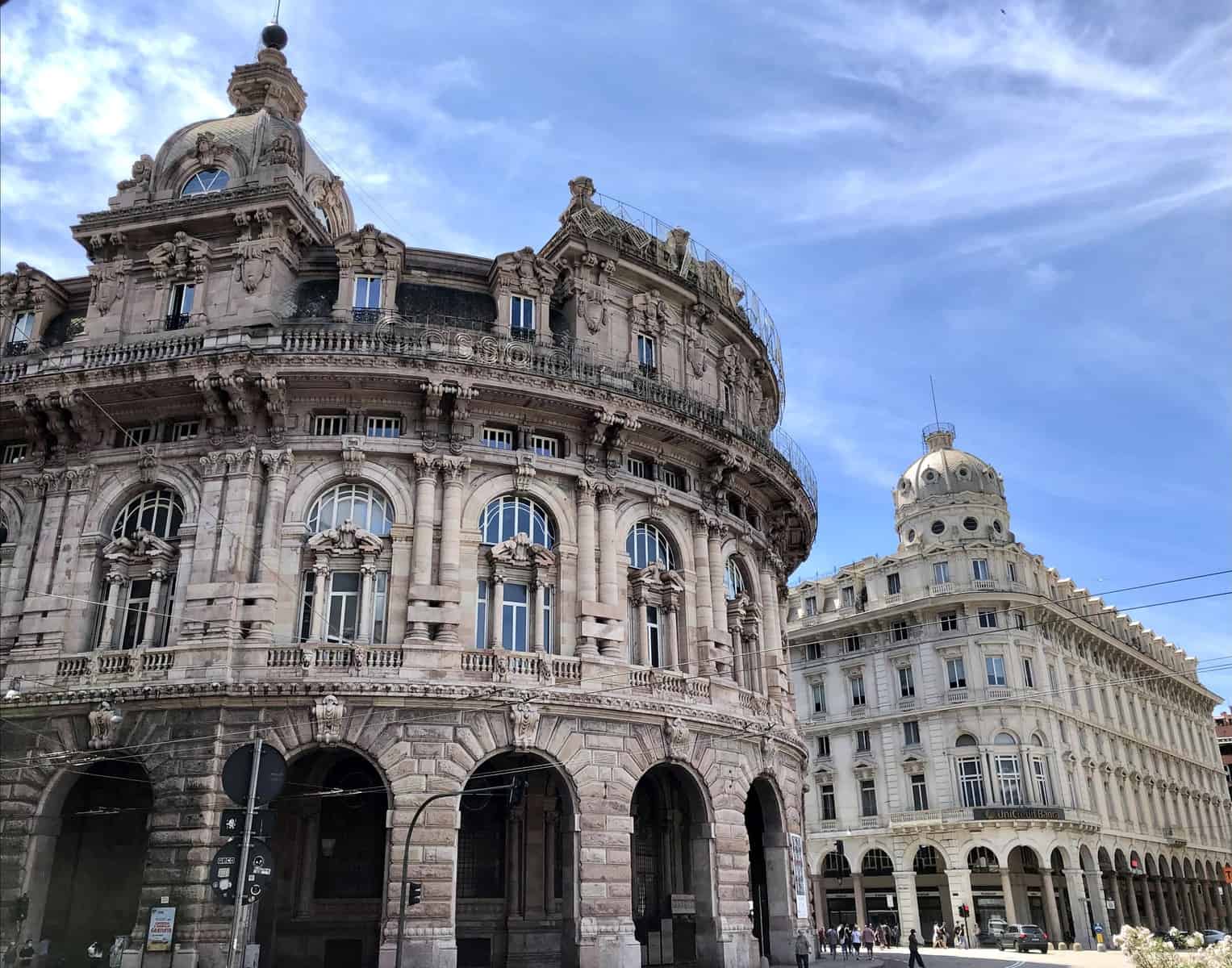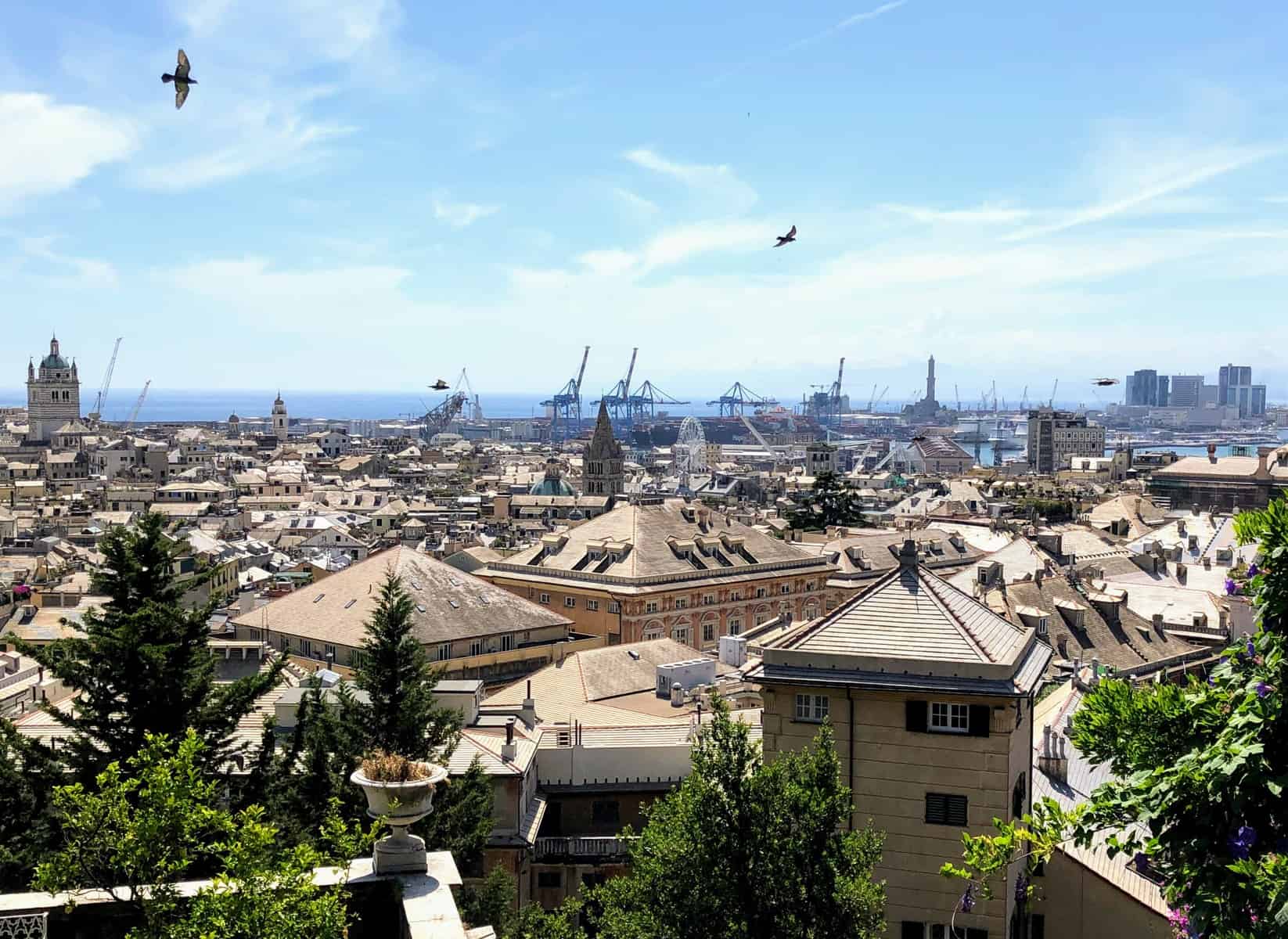A Day in Genoa: From Ferries to Funiculars
Genoa’s nickname La Superba means “the Proud” but compared to the other great Italian city-states, it’s surprisingly down-to-earth. The city’s refreshingly low levels of tourism are somewhat puzzling, given its wealth of sights. Besides the largest medieval quarter in Europe, Genoa boasts 114 palaces including 42 World Heritage sites, 20 art museums, an aquarium, and a maritime museum. The urban center is surrounded by verdant hills accessible by foot or a series of historic funiculars. Some of Italy’s best beaches and seaside villages are close at hand with Genoa’s easy-to-use network of ferries, trains, and buses.
We visited Genoa as a day trip from the nearby resort town of Camogli. While we could have easily stayed a week, one day gave us enough time to sample the city’s highlights – not to mention copious amounts of its famous pesto. We found Genoa less flashy in feel and less expensive overall than other parts of Italy.
Genoa’s port: the heart of the city

Ferries are a great way to travel to Genoa, since the city’s two main train stations aren’t in the historic center. The Porto Antico (Old Port) is Genoa’s physical and spiritual heart and makes a natural starting point for any visit. Approaching the city from the water, it’s difficult to fathom the harbor’s size: we passed miles of mega cruise ships, looming like skyscrapers and dwarfing our ferry – and they only occupied a small fraction of the port.
In the harbor’s ancient center, centuries of grit were cleared away in the early 90’s to make room for a series of projects by star architect and native son Renzo Piano. In addition to restoring some of the larger warehouses, he designed the Biosphere, the Bigo Panoramic Lift and tent-like Piazza delle Feste. The latter houses concerts and other events; when we visited, it was hosting a vinyl record fair. The area also includes a ferris wheel as well as a slew of lively cafes, restaurants, and bars. The biggest attractions, however, are the Museum of the Sea and Genoa’s reknowned aquarium.

Just behind the port lies the Piazza Banchi, originally the city’s financial hub. It’s watched over by the Church of San Pietro, a very rare hybrid of religious and commercial architecture. Authorities cleverly financed the construction costs by selling business space in the ground floor arcade – and then built the church directly on top.
The medieval quarter: caruggi and churches
Surrounding the Porto Antico, Genoa’s medieval quarter begs to be explored. Tiny pedestrian streets called caruggi slice through towering buildings and provide shelter from the blinding sun of the harbor. No two buildings look quite the same, although they all squeeze about six or seven stories into a narrow plot. Updates over the years make it nearly impossible to date any of them. Any given structure might mix Baroque shrines, antique frescoes, and street art.


Interspersed throughout the historic quarter, Genoa’s medieval churches function as congregation points for residents of all ages. The Cathedral of San Lorenzo attracts the biggest numbers.


Begun in 1118, the duomo inaugurated the use of black-and-white stripes found throughout the city. Flanked by enormous and curiously mournful-looking lions, the church was financed largely by the activities of the Genoese naval fleet, which provided transportation and military assistance to Crusaders. Ancient Roman ruins have been found on the site, which may have started as a burial ground.

Other notable churches include the San Matteo, commissioned by the powerful Doria family, with coordinating stripes on the buildings around its piazza.
Genoa’s Baroque center and the Via Garibaldi palazzos

Just past the San Lorenzo, the Piazza Matteotti leads into the Baroque section of Genoa. The Palazzo Ducale and the Church of the Gesù both embody the flamboyant style of the years when Genoa’s focus shifted from naval power to banking power.

The city’s political ties to Spain made it the financial center for the wealth flooding in from the New World. (It’s not a coincidence that Christopher Columbus came from Genoa.) The Piazza di Ferrari serves as the city’s main square, with a large fountain in the middle. It’s surrounded by grand – some might say grandiose – architecture, including the stock exchange and the opera house. We were taken with some of the streets radiating off of it, with lovely arcades and terrazzo walkways.


Back across the medieval quarter lies the remarkable sight of the Via Garibaldi, an entire street full of palaces. Formerly known as the Strada Nuova, it houses a series of UNESCO World Heritage sites.

Built from the mid-16th to 17th centuries, the Palazzi dei Rolli give late Renaissance and early Baroque architecture a regional twist, with bright colors and Ligurian trompe l’oeil painted accents. The sizable collection of art on display in the Palazzo Rosso, Bianco, and Doria Tursi includes work by Caravaggio and Van Dyke.
Genoa’s hills: pathways, funiculars, and gardens
For atmospheric neighborhoods and views of the city, head for the hills. Countless ancient pathways known as creuze crisscross the hillsides, winding between palaces, up alleyways, across hidden piazzas, and even tunneling through buildings. We stopped bothering with maps and simply headed ‘up’. The area mixes bungalows with palaces, interspersed with secret gardens, ancient churches, and mini piazzas. Eventually we wound up in the Villetta di Negro, an immense park with views, grottoes, waterfalls, and almost no people.

When your feet get tired, ride the funiculars and lifts. Vertical transportation in Genoa is easy, scenic, and fun. Notable routes include the Art Nouveau Spianata Castelletto which takes visitors up from the Piazza Portello, just off the Via Garibaldi, to the Belvedere Montaldo.
At the top of the Via Balbi, the Montegalletto is the world’s only lift to move both horizontally and vertically. It runs out to the Corso Dogali, where the D’Albertis Castle houses the Museum of the Cultures of the World.

Finally, the Zecca-Righi funicular is a 20-minute ride from the Largo Zecca out to the old defensive castles and forts ringing the city. The area features hiking trails through the woods, more beautiful views of the coast and the city, and a 16th century sanctuary.
List of funicular/lifts routes and timetables
AMT, Genoa’s transportation network, sells €2 tickets which work on the bus and subway as well as funiculars and lifts. A 24-hour pass costs €10.
Near Genoa: beaches and regional parks
For anyone staying in Genoa, beaches and nature areas are close at hand.

The Corso Italia serves as Genoa’s main promenade, and runs to the fishing village of Boccadasse, with colorful buildings and a pebble beach. A 15-minute bus or train ride takes visitors to Nervi, a seaside village with a Roman bridge, a celebrated park, and an exquisite path along the sea.
Genoa divides Liguria into two parts, with the Riviera di Ponente on the west and the Riviera di Levante on the east. Most of the beaches close to the city lie on the eastern side, easily accessible via ferry or train. For more on the area, see our posts linked below.
Several regional parks surround the city, including the Antola Natural Regional Park, while the coastline has been declared a sanctuary for sea mammals.
Genoa practicalities
Best all-in-one resource: Genoa visitor information website
Most churches in Genoa close between 12-3 pm.
Genoa museums
Aquarium, Biosphere, and Bigo panoramic lift tickets and information
Genoa Museums website covers most other museums
Genoa transportation
The Golfo Paradiso website has information, schedules, and prices for regular ferries and whale-watching excursions.
Genoa’s two main train stations are Brignole and Piazza Principe.
For Nervi, take bus line 15 from Brignole station.
Further Reading
Our other posts on the region include A Guide to Camogli & the Towns of the Portofino Peninsula and Cinque Terre.

